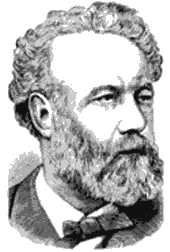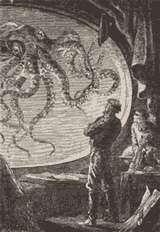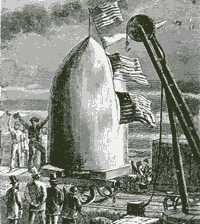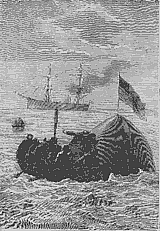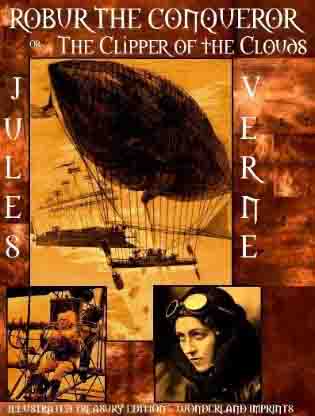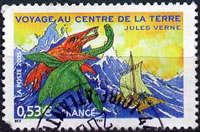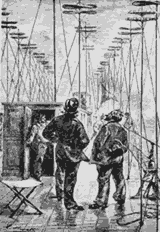
| French Home Page |
| Paris Home Page |
| Icons of France |
| Famous French People |
| 19th Century France Home Page |
| Christmas in France |
| Chateaux in France |
| A writer | ||||||||||
Jules Verne made a name for himself with travellers' tales - stories which tell about the adventures people have on journeys. In his life time he wrote 54 major novels which were about life in the future - science fiction. Jules Verne was born in the sea port of Nantes in 1828. His family had a sea faring ancestry which fascinated the young Jules so much that he ran away from home to be a cabin boy on a merchant ship. He was soon caught out, and sent back to his parents. Later, Jules Verne went to Paris to study law, but discovered the theatre. He published his first play in 1850, three years after arriving in Paris. His father was furious when he discovered that Jules had given up his legal studies. He cut off his allowance, so Jules had to make money from selling his works in order to live. Jules spent a long time studying geology, astronomy and engineering in the libraries of Paris. He looked at the inventions which had been made in his own life time and then added to them his visions and dreams for the future. He was able to invent a future that did not exist until well into the twentieth century. Jules Verne is one of those authors that make you wonder if time machines have been invented after all!
Verne's capsule also had three astronauts on board (two of them American and one Frenchman, in the spirit of international cooperation); it used a chemical system to generate oxygen and another to extract carbon dioxide during the trip and it made a slingshot trip (named Free Return Trajectory a century later) around the Moon in order to return to the Earth.
"Robur the Conqueror" (1886) told the story of a master vilain, who wanted to rule the world. In his propellor driven airship, the Albatross, Robur seeks his aim of world domination. The first real flight occured in 1903. "Around the World in 80 days" must have encouraged many people in the last century to travel internationally. Even today, it can be a challenge to achieve Jules Verne's journey in his time limit.
An interesting and little known fact: One of Jules' earliest works was a novel dating from 1863 that was called Paris in the 20th Century. Jules imagined a Paris that had glass high rise, cars powered by gas engines, calculators, high speed trains and a global communication network. The hero was a young man who could not find happiness in spite of all the wonderful things around him. He died a tragic death. Verne's publisher thought that this sad ending would harm Verne's popularity and advised him to put the book aside and maybe publish it 20 years later. Verne tucked his book away in his safe, and thought no more of it. It remained there, forgotten, until his great grandson discovered it over a hundred years later in 1989. It was finally published in 1994! |
| The father of Science Fiction. | ||
|
Jules Verne is often called "the father or science fiction" for he wrote about concepts and ideas which were far into the future.
Verne loved to invent machines for his imaginary travels in the future. Click here to discover 8 Inventions of Jules Verne that came true Wow! This is a list of Verne's books! He was a very prolific writer! It is claimed that he is one of the most translated authors of the world. His books are as popular today as they were when they were first published - a tribute to the imagination and inventiveness of their author. You can see from the dates that Verne published one, sometimes two books per year !
Five Weeks in a Balloon (Cinq Semaines en ballon, 1863) Paris in the 20th Century (Paris au XXe Siecle, 1863, not published until 1994) Journey to the Center of the Earth (Voyage au centre de la Terre, 1864 From the Earth to the Moon (De la terre à la lune, 1865) Journeys and Adventures of Captain Hatteras (Voyages et aventures du capitaine Hatteras, 1866) In Search of the Castaways or Captain Grant's Children (Les Enfants du capitaine Grant, 1867-1868) Twenty Thousand Leagues Under the Sea (Vingt mille lieues sous les mers, 1870) "Around The Moon" Autour de la lune, a sequel to From the Earth to the Moon, 1870 A Floating City (Une ville flottante, 1871 Dr. Ox's Experiment(Une Fantaisie du Docteur Ox, 1872) The Adventures of Three Englishmen and Three Russians in South Africa (Aventures de trois Russes et de trois Anglais, 1872 ) The Fur Country (Le Pays des fourrures, 1873) Around the World in Eighty Days (Le Tour du Monde en quatre-vingts jours, 1873 The Survivors of the Chancellor (Le Chancellor, (1875) The Mysterious Island (L’île mysterieuse, 1875) The Blockade Runners, ( 1875) Michael Strogoff (Michel Strogoff, 1876 Off On A Comet (Hector Servadac, 1877) The Child of the Cavern, also known as Black Diamonds or The Black Indies (Les Indes noires, 1877 Dick Sand,) A Captain at Fifteen (Un Capitaine de quinze ans, 1878) The Steam House (La Maison à vapeur, 1879 Eight Hundred Leagues on the Amazon (La Jangada, 1881) The Green Ray (Le Rayon vert, 1882) The Headstrong Turk (1883) The Vanished Diamond (L’Étoile du sud, 1884 The Archipelago on Fire (L’Archipel en feu, 1884 Mathias Sandorf (1885) Robur the Conqueror or The Clipper of the Clouds (Robur-le-Conquérant, 1886 Ticket No. "9672" (Un Billet de loterie, 1886) North Against South (Nord contre Sud, 1887) The Flight to France (Le Chemin de France, 1887) Two Years' Vacation (Deux Ans de vacances, 1888 Topsy Turvy, (1890) The Castle of the Carpathians (Le Château des Carpathes, 1892 Propeller Island (L’Île à hélice, 1895) The Purchase of the North Pole (Sans dessus dessous, the second sequel to From the Earth to the Moon, 1895 Facing the Flag (Face au drapeau, 1896) Clovis Dardentor(1896 The Sphinx of the Ice Fields or An Antarctic Mystery (Le Sphinx des glaces, a sequel to Edgar Allan Poe's The Narrative of Arthur Gordon Pym, 1897 The Mighty Orinoco (Le Superbe Orénoque, 1897 The Village in the Treetops (Le Village aérien, 1901 The Master of the World(Maître du monde, sequel to Robur the Conqueror, 1904 Invasion of the Sea (L’Invasion de la mer, 1904 A drama in Livonia (Un Drame en Livonie, 1904 The Lighthouse at the End of the World (Le Phare du bout du monde, 1905 The Chase of the Golden Meteor (La Chasse au météore, 1908 The Danube Pilot (Le Pilote du Danube, 1908 The Survivors of the 'Jonathan' (Le Naufrages du Jonathan, 1909
|
||
On other pages
Did you know?

This is the flag of Paris.
Notre Dame was nearly demolished. It was only saved by Victor Hugo's campaign to save it. Click here to find out more.

Sacré Coeur is not really that old. Click here to find out about it.

The Parisians hated the Eiffel Tower when it was first constructed. They wanted to pull it down. Click here to find out more
